Zotac Z68ITX-A-E Wifi Review - Mini-ITX meets Z68
by Ian Cutress on September 22, 2011 10:01 AM EST- Posted in
- Motherboards
- Mini ITX
- ZOTAC
- Z68
As we often see with the 'lower tier' manufacturers, their BIOS implementations are usually a standard interface with very few specific vendor related options. Zotac's Z68 is no different - here's an American Megatrends default BIOS with options specific to this board.
The front screen doesn't give much detail - I've mentioned time again in these reviews that when I go into a BIOS I want the most important info (CPU, speed, voltages, fan speeds, memory size and timings) when I go straight in. So far, only ASUS have the best version of this, and to be honest, it shouldn't take BIOS engineers that long to add these features in.
There are usually two types of BIOS - ones that have every option under the sun included in them, and others which are essentially stripped bare so users cannot fiddle with too many settings. The Zotac Z68ITX-A-E falls sort of into the middle - there's basic overclocking options that are easy to find and implement, and basic fan controls, but nothing too involved, such as 'auto OC' options.
In terms of overclocking options, in the CPU overclock menu, both SpeedStep and Turbo Boost have to be enabled in order to change any overclock options. There's no ability to underclock the voltage either - the only option is to increase a CPU Turbo voltage offset, rather than select an absolute voltage. The only voltages changeable are the CPU Turbo offset, the memory voltage, PCH voltage, additional graphics voltage - no others like PLL are available to be adjusted.
There are a couple of overclock issues I found. Despite not having a setting to implement XMP memory profiles, if you select a memory speed such as 2133 MHz, if you then reselect back to 'Auto', the board will boot at 2133 rather than any 'auto' setting. This memory speed is also kept between CMOS resets and resetting the BIOS back to defaults, meaning the user has to go back and manually adjust the memory speed to get an 'auto' value.
CPU fan controls are limited, given that there are only two fan headers on board. By default, the CPU fan has a ramping scheme involved, and the SYS fan is stuck at 80%. Unfortunately, even with user intervention, the options will not allow more than 80% speed. As there isn't any fan software in the OS, this is the user limit.
Multi-monitor setups with the integrated graphics have to be enabled in the BIOS, as well as changing the mini-PCIe into an mSATA. Thankfully this BIOS allows an override for a quick single boot from a separate device without having to change the boot order.
Overclocking
Unfortunately, this motherboard is seriously let down by the overclocking. Some of this is expected - we're dealing with a mini-ITX which historically doesn't support that much overclocking, especially on high performance platforms, but the Zotac does fall short in almost all areas.
The first thing of note is that the Turbo mode on the Zotac board is not properly implemented as per Intel specifications by default. Normally, on my i5-2500K CPU, it has a 33x base multiplier, and increases by 4x (to 37x) under single threaded load, to 1x (to 34x) under multithreaded load. Due to how this motherboard works, that 4x turbo boost is applied no matter what the load in the OS. This naturally provides the consumer with a natural boost on multithreaded applications whilst at stock speed over every other board available for the Cougar Point platform. The rebuke is that it makes it unfair against other manufacturers, as in order to beat this board, will also provide out-of-spec capabilities by default.
In terms of overclocking the CPU, the options are limited - in terms of voltage, only a positive offset is applicable (thus no underclocking on the voltage). The CPU multiplier is a simple adjust, but both SpeedStep and Turbo Boost have to be enabled in order for an overclock to be used (otherwise the CPU defaults to 33x in the OS). Having these two enabled naturally introduces instability to an overclocked system as the system will reduce the CPU clock and voltage when not under load - when the margins are larger than Intel specifications, there's a chance that the CPU could initiate the clock before the voltage, causing the system to lock up, which is what we see:
The CPU successfully booted and was stable at a 44x multiplier, but anything above that refused to boot. At 44x, the full multithreaded load voltage was 1.32 V, so I applied a +100 mV offset (to lead to 1.42 V, my standard OC voltage for Cougar Point reviews). However the system would lock up after finishing any CPU intensive benchmark, probably due to this voltage change when the CPU clocks back down. By upping the power limits, it was also unstable in this format, leaving 44x the best CPU overclock possible. This is relatively disappointing for a Cougar Point motherboard given what we've seen previously, however this is a mini-ITX with lots of additions, so I was kind of expecting this, however it is in contrast to the 'Super Overclock' motif on the board itself. Given this motif, it was disappointing not to see an easy 'OC' mode with predefined speeds, as seen on other manufacturers boards.
In terms of memory, the board has the option to change from 1066 to 2133 MHz. There is a small issue though as mentioned above - if you select any speed on manual, then switch back to auto, the board would attempt to boot at the speed you selected, rather than just an automatic speed. There is also no option to apply any XMP profiles for the memory, which should be a BIOS standard, nor is there an option to adjust the command rate of the memory in the sub-timing options. The memory voltage can be changed in both a positive and negative offset, but no absolute values are given. There was some slight issues at 2133 MHz though - every so often, the board would apply DDR3-2133, but not any CPU overclock applied, resulting at 33x at all loads.
For the iGPU overclock, there are only three options which make it simple - Turbo iGPU speed, additional iGPU voltage, and an iGPU Current Limit. By applying no additional voltage and merely increasing the iGPU clock, I got the following results on our Metro 2033 settings:
Stock: 18.2 FPS
1400 MHz: 21.4 FPS
1500 MHz: 22.3 FPS
1600 MHz: 23.1 FPS
1700 MHz: Fail
In an attempt to mix all these overclocks, I tried applying them all at once - a 44x multiplier, 2133 MHz memory and 1600 MHz GPU. Unfortunately, at these clocks, the system would lock up at the very start of Metro 2033. After changing around the settings, it seems that mixing the iGPU and CPU overclock leads to a large enough power draw to cause the lockup.
Ultimately, it seems this board works well at stock (with that out-of-spec CPU speed in multithreaded), but not so well in any overclocked mode.


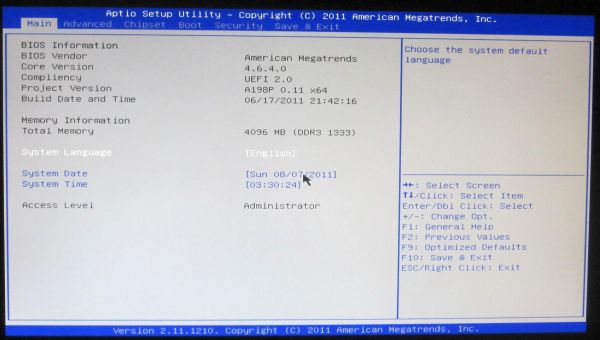
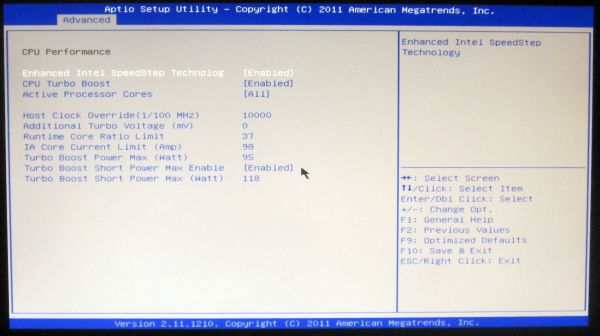
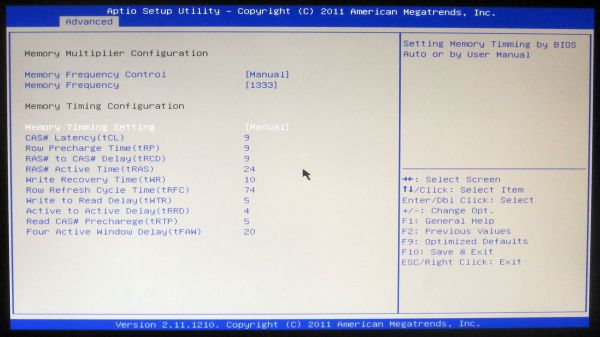
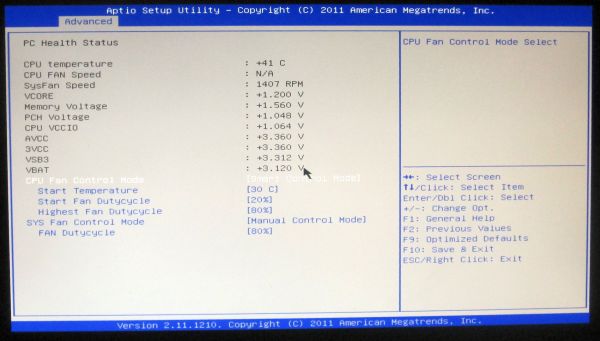
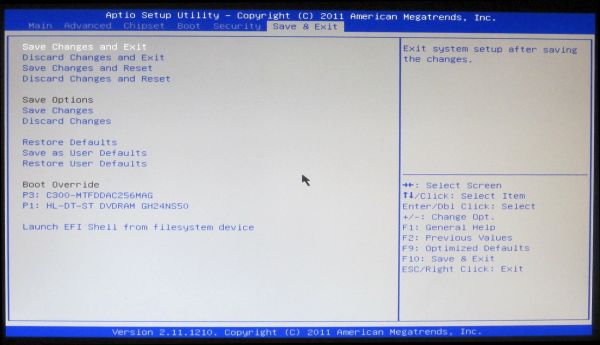














29 Comments
View All Comments
GeorgeH - Thursday, September 22, 2011 - link
This review mirrors my experiences with Zotac motherboards - awesome hardware on paper that's completely let down by abysmal BIOS and tweaking support.dlang1234 - Thursday, September 22, 2011 - link
Heat and noise...More interested in those, looks like an awesome HTPC. mini itx usually isn't targeted at a gamer, but Home Theaters or specific in car or other unique installations.
I'm more interested in how well it would work playing Blu-Rays, streaming media all at 1080p. Audio over HDMI? etc..
Anosh - Thursday, September 22, 2011 - link
There's a new version of the bios which seems to fix some of the issues mentioned (XMP, undervolting etc) and it would be great if you could take a look at what they tried to fix and what they actually managed to fix.I've had this board under consideration for a long time now since it's one of the few 1155 itx with both displayport and hdmi (and wifi) but I'm glad I didn't go for it since there are so many issues floating around (buzzing, faulty memory slots, doa, lacking bios, stops booting after x months etc) that I would've had to replace it not long after getting.
I've read retailers are dumping zotac inventory based on the horrible experiences customers have had with this product. Also there seems to be new revision under way.
I'm typing this on an iPoop so trying to find all the reference links to backup my claims would take forever but search a bit and you'll discover they're easy to find.
mayankleoboy1 - Thursday, September 22, 2011 - link
all the other boards are tested with c300 and this board is tested with vertex3, gibing higher numbers??IanCutress - Thursday, September 22, 2011 - link
We tested the board with both, and both results are given in the graphs.OCZ were kind enough to provide Vertex3s for Brendan and I to use in future reviews (Brendan does not have access to a C300), but we currently do not have enough Vertex3 results to warrant a graph using purely Vertex3 results So for the time being we're showing C300 results with an example of what happens with the Vertex3.
All the best,
Ian
Breathless - Thursday, September 22, 2011 - link
Why would you not have updated the bios prior to doing the review? The bios has been out for quite some time now...IanCutress - Thursday, September 22, 2011 - link
Simply put, a lot of people never update their BIOSes from the shipping version, so we have to test that. With the Intel spec issues, when the testing for this board was done, Zotac sent me the BIOS while it was still in beta phase, and I've been in contact with Zotac regarding the issues I was having with that beta release (the DIMM slot not working being a big issue). It seems to have been pushed into a full release since then (as of 9/9), despite my issues. As a result, I have updated the review to notify it is now a full BIOS release.Ian
Mr Perfect - Thursday, September 22, 2011 - link
Do you have any information on what caused the DIMM slot to fail? There is one guy on HardForums who, after having that problem on his own machine, then went on to test every board he had in stock at his shop. I'm not sure if it's something he was doing, or a fault with the design, but every one he tried had that issue.FATCamaro - Thursday, September 22, 2011 - link
You barely talked about stability. Reviews are useless without it to me. I'd rather look at the star rating on newegg to figure out whether i want the board or not. It's the single most important aspect, yet it doesn't even get lip service.Iketh - Thursday, September 22, 2011 - link
how could he comment on stability? if he didnt experience any and thus didn't comment on it, it's quite obvious that it ran fine... newegg's ratings are a bunch of boards from daily users, this is one board that was ran through benchmarks... so how the hell can you ask him to, at the minimum, reproduce newegg's results???